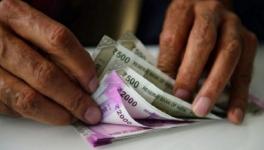Thwarted NSSO Report Pegs Unemployment Rate at 4-Decade High of 6.1% in 2017-18

New Delhi: The country’s unemployment rate stood at a 45-year high of 6.1% during 2017-2018, according to the National Sample Survey Office (NSSO’s) Periodic Labour Force Survey (PLFS). As reported in the Business Standard, the report is at the centre of controversy after two National Statistical Commission (NSC) members, including acting chairman, resigned on Monday, alleging that the government had withheld it’s release despite the NSC’s approval.
The report, which has the potential to nail the Narendra Modi government’s claims on unemployment as well as expose its hollow promises on job creation, has not been made public yet.
The findings of the report hold significance as this is the first comprehensive survey on employment conducted by a government agency after Prime Minister Narendra Modi announced demonetisation of high valued currency notes in November 2016.
According to the Business Standard, which has reviewed the documents, the unemployment rate in 2017-2018 was at its highest level since 1972-1973-- the period since when the jobs data is comparable.
In 2011-2012, the unemployment rate stood at 2.2%, according to the NSSO survey. PLFS is the first annual household survey of the NSSO, conducted for July 2017- June 2018.
The NSSO report shows that joblessness was higher in urban areas (7.8%) than the rural parts (5.3%) of the country. Also, more people were withdrawing from workforce as the labour force participation rate (LFPR) stood at a lower level than the previous few years.
Himanshu, associate professor at Jawaharlal Nehru University was quoted by Business Standard as saying, “We are in the middle of a deep jobs crisis, though the reason cannot be entirely attributed to demonetisation as this had building up for quite some time. Job creation was low even during the previous government’s tenure.”
The joblessness rate among youth was at a significantly higher level in 2017-2018 compared with the previous years and “much higher compared to that in the overall population”, according to a report. For instance, the rate of joblessness among rural males in the age group of 15-29 years jumped more than three times to 17.4% in 2017-2018 compared with 5% in 2011-12.
Similarly, the unemployment rate for female youth in rural areas stood at 13.6% in 2017-18 compared with 4.8% in 2011-12. “The youth is moving away from the agriculture sector as it is becoming less remunerative and moving to urban areas. The construction sector is one of the biggest employees in urban areas, but in 2017-2018, we saw a major turmoil in the sector,” Madan Sabnavis, Chief Economist at CARE Ratings, said. Significantly the Labour Force Participation Rate (LFPR)- the proportion of population working or seeking jobs- declined from 39.5% in 2011-2012 to 36.9% in 2017-2018.
The LFPR has been declining since 2004-2005. The dip in LFPR was at a higher pace in 2017-2018 compared with 2011-2012, but at a lower speed than what was witnessed in 2009-2010. The unemployment rate among the educated also went up in 2017-2018 compared to 2004-2005.
The report noted, “for educated rural females, the unemployment rate ranged from 9.7% to 15.2% during 2004-2005 to 2011-2012, which rose to 17.3% in 2017-2018.” For rural educated males, the unemployment rate rose to 10.5% in 2011-2012, which ranged from 3.5-4.4 % during 2004-2005 to 2011-2012.
P.C. Mohanan, the acting chairman of the National Statistical Commission (NSC) and a retired career statistician, and J.V. Meenakshi, a professor at the Delhi School of Economics had resigned on Monday, January 28, protesting against the decisions that had rendered the commission “ineffective”.
Mohanan had said that there were not only one or two issues and the commission was being bypassed by the Ministry on a number of other issues as well. The officers asserted, “We have resigned from the NSC. Over the months, we have been feeling that we were not taken seriously and were being side-lined by the government. Recent decisions of the NSC were not being implemented.”
Former chairman of the NSC, Pronab Sen, had reacted to this by saying that the NSC was essentially meant to bring about a sense of credibility to the data put out by the National Statistical System, and if the NSC felt that it was not being permitted to carry out its functions, then it was entirely appropriate that to resign.
Ever since the findings came out, the BJP has been facing a lot of flak for trying to suppress the NSSO report by various organisations and political parties.
Reacting to the report, Congress President tweeted: "NoMo Jobs! Unemployment is at its highest in 45 yrs. 6.5 Cr youth are jobless in 2017-18 alone. Time for NoMo2Go..."
Demanding immediate release of all the data, the CPI(M) demanded that it be tabled and discussed in Parliament, as the people of the country have the right to know the “grim realities” that they are facing.
“The suppression of data is a clear admission on the part of the Modi government that its policies have resulted in greater misery for our people. India’s youth which is our asset, is being wasted. It also exposes the utter failure of the BJP-led government to deliver two crore jobs every year,” the statement added.
https://www.newsclick.in/index.php/two-nsc-members-resign-claim-commission-bypassed-government
https://www.newsclick.in/sword-mounting-unemployment-hangs-over-modi
Get the latest reports & analysis with people's perspective on Protests, movements & deep analytical videos, discussions of the current affairs in your Telegram app. Subscribe to NewsClick's Telegram channel & get Real-Time updates on stories, as they get published on our website.
























